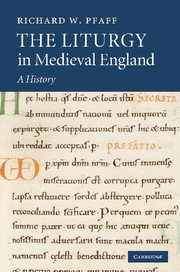Book contents
- Frontmatter
- Contents
- Preface
- Sigla and editorial conventions
- Bibliographical abbreviations
- Nicknames for manuscripts frequently referred to
- 1 Introduction
- Excursus: on sources
- 2 Early Anglo-Saxon England: a partly traceable story
- Excursus: on the terms Gregorian and Gelasian as used here
- 3 Later Anglo-Saxon: liturgy for England
- 4 The Norman Conquest: cross fertilizations
- Excursus: on method in the comparison of liturgical texts
- 5 Monastic liturgy, 1100–1215
- Excursus: on ascription of liturgical books to specific churches
- 6 Benedictine liturgy after 1215
- 7 Other monastic orders
- 8 The non-monastic religious orders: canons regular
- 9 The non-monastic religious orders: friars
- Excursus: on liturgical books from female religious houses
- 10 Old Sarum: the beginnings of Sarum Use
- 11 New Sarum and the spread of Sarum Use
- 12 Exeter: the fullness of secular liturgy
- 13 Southern England: final Sarum Use
- 14 Regional Uses and local variety
- 15 Towards the end of the story
- Index of Manuscripts
- Index of Saints
- General Index
Excursus: on ascription of liturgical books to specific churches
Published online by Cambridge University Press: 20 March 2010
- Frontmatter
- Contents
- Preface
- Sigla and editorial conventions
- Bibliographical abbreviations
- Nicknames for manuscripts frequently referred to
- 1 Introduction
- Excursus: on sources
- 2 Early Anglo-Saxon England: a partly traceable story
- Excursus: on the terms Gregorian and Gelasian as used here
- 3 Later Anglo-Saxon: liturgy for England
- 4 The Norman Conquest: cross fertilizations
- Excursus: on method in the comparison of liturgical texts
- 5 Monastic liturgy, 1100–1215
- Excursus: on ascription of liturgical books to specific churches
- 6 Benedictine liturgy after 1215
- 7 Other monastic orders
- 8 The non-monastic religious orders: canons regular
- 9 The non-monastic religious orders: friars
- Excursus: on liturgical books from female religious houses
- 10 Old Sarum: the beginnings of Sarum Use
- 11 New Sarum and the spread of Sarum Use
- 12 Exeter: the fullness of secular liturgy
- 13 Southern England: final Sarum Use
- 14 Regional Uses and local variety
- 15 Towards the end of the story
- Index of Manuscripts
- Index of Saints
- General Index
Summary
Bury St Edmunds as test case
Fundamental to this work is the capacity to ascribe an extant liturgical manuscript to a particular establishment, secular or monastic. A brief explanation as to how this is done – by what methods, with what degree of confidence, and at what risk – may be found useful, and may best be approached not so much through setting down abstract principles as through tracing one case study. For this purpose it seems desirable to choose an establishment for which, though there is a great deal of documentation in a number of respects, not many ascribable liturgical books have survived: the abbey of Bury St Edmunds, a twelfth-century missal from which was discussed a few pages ago.
Bury has the further advantage that its monastic past extends only to 1020, when King Cnut established monks there to replace the shadowy community of canons who had kept the shrine of St Edmund, the East Anglian royal martyr killed by the Danes on November 21st (the traditional date, anyhow), 869. The immediate source of its original monks seems to have been the Norfolk monastery at Holme St Benets, but as this had been (re)founded only in 1019, what would seem material is the founding impetus for that house: apparently Ely. If this, which is certainly plausible, is true, we can hope for traces of the much better documented abbey of Ely in particular and of the thelwoldian sphere of influence in general.
Fortunately, surviving information about the Bury's library is as full as that about its liturgical books is scanty.
- Type
- Chapter
- Information
- The Liturgy in Medieval EnglandA History, pp. 192 - 199Publisher: Cambridge University PressPrint publication year: 2009



